Bhaktapur was the first place that we visited on our Nepal trip. It was not a planned decision though. While on our bus from Kakkarbhitta to Kathmandu, one of our co-passengers told us that Bisket Jatra is going to be held at Bhaktapur the next 2 days. And at that moment, we changed our plans and decided to stay at Bhaktapur instead of Kathmandu and attend the festival. Bhaktapur is one of the ancient cities of Nepal famed for the Bhaktapur Durbar Square. Usually, a day trip to Bhaktapur Durbar Square is more popular, but we would definitely recommend you to stay there for at least one night. The place is simply gorgeous and much more than a day visit on your Kathmandu itinerary.

Bhaktapur is a living heritage or as they call it “A Living Museum” of Newari art and architecture. It is a place where you will see the ancient Newari traditions playing along, the Nepal men in their Bhadgaule Topi (Black cap) and women in Haku Patasi (traditional black saree with red border) walking along the alleys and the ornate wooden pagodas standing tall amidst all the cacophony of a busy town. The Bhaktapur Durbar Square is the main square in the city, the major attraction having a conglomeration of stone and metal art, wood carvings and terracotta art and architecture. Everything is simply mind-blowing here. The best part, however, was that we visited during the time of Bisket Jatra, the Nepali New Year and so experienced the traditional and cultural part of this ancient city.

Bhaktapur: A glimpse into the Newari past, culture and tradition
Bhaktapur is known as the cultural capital of Nepal. There are other monikers also given for this ancient city like “Living Heritage” and “Ancient Newari Town”. And Bhaktapur Durbar Square was one of the places where we enjoyed the most in Nepal.
Bhaktapur is known as “Khwopa” in the local Newari tongue and was the largest of the three Newari kingdoms. It was the capital of the entire Nepal kingdom from 12th century to 15th century AD. It is said that Bhaktapur is shaped like a flying pigeon spread over an area of 6.88 sq km.
Bhaktapur is a blend of art and mythology, the very essence of Newari tradition, art and architecture loom large in Bhaktapur. Majority of its residents are either Hindus or Buddhists by religion and together they live in perfect religious harmony. Infact, in Nepal, this intermingling of Hindu and Buddhist traditions are quite apparent. Both religions borrow rituals and customs from each other and make a unique cultural identity.
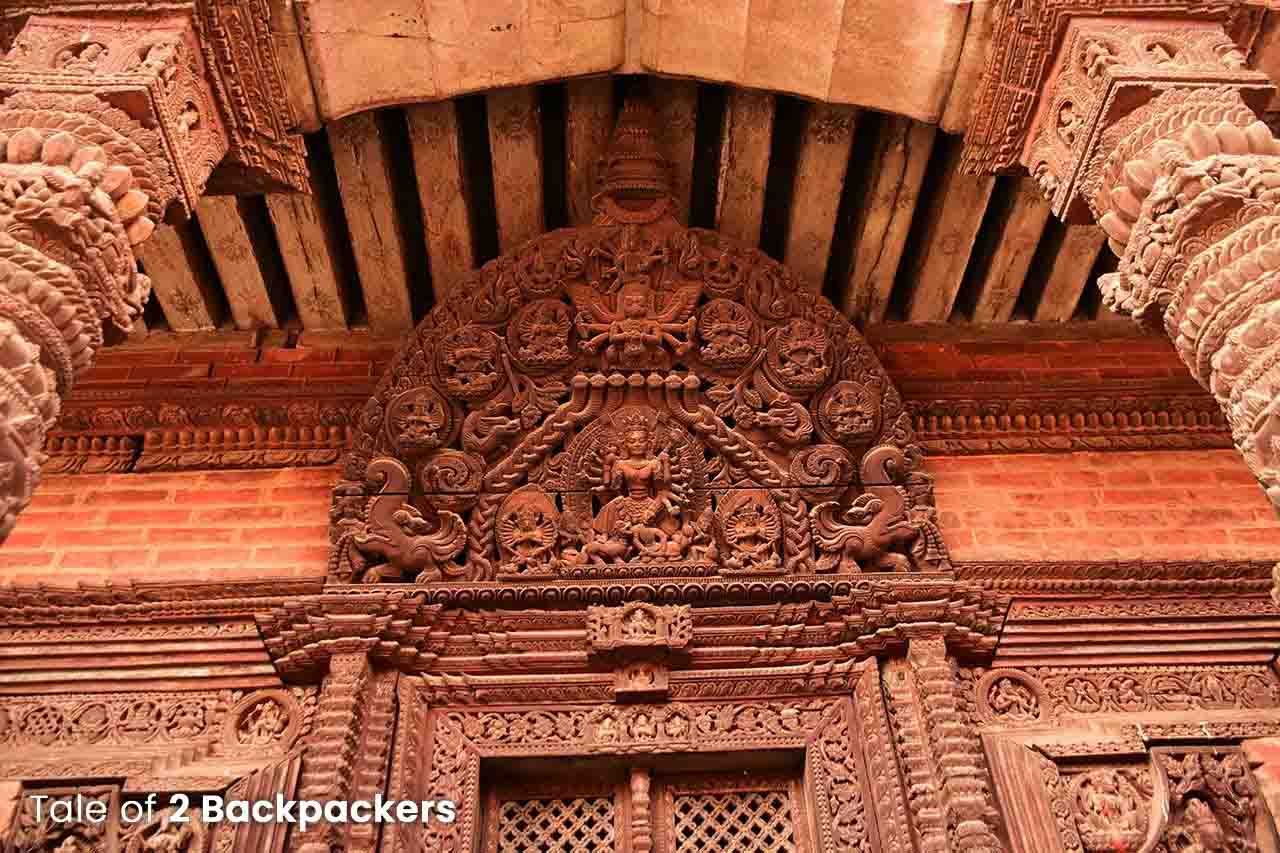
The ancient architecture of Bhaktapur is inherited from the earlier generations. The pagoda and shikhar style temples, Vihars, Bahls (traditional Buddhist monasteries in Nepal) and the Chowks, Dyochhens (residence of the Hindu deities)water tanks, palaces are the major monuments in the ancient city. And just like Patan and Kathmandu, Bhaktapur Durbar Square lies in the heart of the city.

History of Bhaktapur Durbar Square
Bhaktapur was founded by King Ari Malla (Ari Deva) in the 12th century and was the original seat of power of the Malla dynasty. Infact, King Ari was the first to adopt the name “Malla” meaning ‘wrestler’ in Sanskrit. He made Bhaktapur’s Dattatreya Tole (the oldest square in the city) his capital.
The golden era of the Malla kings was between 1200 AD and 1482 AD. Bhaktapur ruled over the valley and the kingdom prospered under the Malla kings. After the death of King Jayaksha Malla in 1482, the Malla kingdom was divided into three kingdoms for his sons and thus came the three kingdoms of Kathmandu, Bhaktapur and Patan. This era is known as the “Period of three kingdoms”.

This was also the time when the three kingdoms fought many a battle between them. Skirmishes between the brothers were common. However, that was also the time when art, architecture and culture flourished in the valley. There was a rise in temple construction, trade, culture, art as well as language. It was during this period that the Nepali language took its form. The last three rulers of the Malla dynasty were responsible for building the temples and palaces, buildings and Bhaktapur Durbar Square.
The rivalry between the three rulers of Kathmandu, Bhaktapur and Patan increased in the 18th century that also heralded a period of political instability in the Valley. This is when the ambitious Gorkha warlord Prithvi Narayan Shah took over the power from the Malla kings after seeking blessings from the Living Goddess of Nepal.
Currently, Bhaktapur retains most of its historic grandeur and its traditional culture. There is a lot in Bhaktapur that can be explored. The Bhaktapur Durbar Square was enlisted as a World Heritage Site in 1979.


Reaching Bhaktapur Durbar Square
When we arrived at Kathmandu, we thought that the only place to visit is Bhaktapur Durbar Square. But let it be known that Bhaktapur Durbar Square is just a small part of Bhaktapur city, it was only one of the 4 main squares of Bhaktapur. There are many temples and other attractions in Bhaktapur that can simply awe you.
We arrived at Kamal Vinayak Bus stop after a crowded bus ride from Kathmandu. The bus conductor told us that was the place we were looking for. A search in google map there did not yield conclusive results. So we went back to the good old days of asking questions. We were pointed towards a lane and we kept walking with our backpacks.

For the first few metres, it was all modern cemented buildings. Gradually, we found out those small red-bricked Newari structures on both sides of the lane. As it was the day of Nepali New Year, Bhaktapur was crowded that day. People were busy, moving in and out of their houses carrying items of offerings to the Gods. We made our way through the narrow lanes and finally came near Taumadhi Square. Our homestay was located there.
After again resorting to asking directions, we finally found our homestay. Turned out it was a brand new one and we were their very first guests. Aunty was very cordial and looked quite happy to see us. The only problem was that she did not understand English or Hindi. Later her daughter came and we asked her about the place and the festival that was taking place.

The day of Nepali New Year
It was the day of the Nepali New Year as I mentioned before. Bisket Jatra was held around Bhaktapur Durbar Square that day. Bisket Jatra was a spectacle to watch. It was something like the Rathyatra in Puri. Idols of Bhairav and Bhadrakali are placed in huge chariots (rathas) and are pulled through a huge crowd of onlookers. The Bisket Jatra starts (movement of the chariot) after a Tantric ritual in the Bhairab Temple at Taumadhi Square.
Bhaktapur was a place of chaos and crowd that day. The local people went to the temples with their offerings. There were girls and boys dressed in all their Newari finery and performed songs and dance at the squares. Old men played instruments and sang devotional hymns. Everything around was totally colourful and a riot of sound and colours. And it was a complete frenzy all around when the chariots were moved in the afternoon. Well, we did not get an empty Bhaktapur Durbar Square that day to take the best photographs, but what we saw was beyond our expectations. If we had not come on this day, then we would have missed such a firsthand experience of the Nepali culture and tradition.

Must-see attractions in and around Bhaktapur Durbar Square
As I mentioned before, there is a lot to see in Bhaktapur. Even if you are making a day trip here, make sure that you visit the main attractions here. There are 4 main squares in Bhaktapur:
- Durbar Square
- Taumadhi Square
- Dattatraya Square
- Pottery Square

Bhaktapur Durbar Square
Bhaktapur Durbar Square is no doubt the main attraction of the place. It is the main square of the city, also known as the Basantpur Chowk. The entire place is a masterpiece etched in stone and metal, carved in wood and terracotta. The main entrance opens to the area that is known as Basantpur Chowk. It is a sprawling huge courtyard that has various architectural showpieces including palaces, royal baths, temples and of course interesting stories. The courtyard is the part of the royal palace.
Originally, Bhaktapur’s royal palace was the oldest and largest of the palaces in the three cities and was said to have had 99 courtyards. Now, only 5 remain out of all.
-
Lion Gates in Bhaktapur Durbar Square

The Lion gate in Bhaktapur Durbar Square might be in rubbles right now, but it clearly shows how grand the entrance was once. Beautiful and majestic, these were the words in our mind when we saw them.
-
The Golden Gate

The Golden Gate is one of the most beautiful and one of the most intricately decorated gates that we had seen. Locally the gate is known as Lu Dhowka and you cannot but miss this golden gate shining down on you at the Bhaktapur Durbar Square. The female figure on the gate is that of Goddess Taleju, the patron deity of the Malla Kings. She has many heads and 10 arms and is surrounded by her attendants. There is a sculpture of Garuda above the Goddess.
-
The Palace of 55 Windows

The palace is located right in the centre of Bhaktapur Durbar Square and is undoubtedly a masterpiece in woodwork and carvings. The Palace of 55 windows, also known as Pachpanna Jhyale Durbar was built by King Bhupatindra Malla but was completed only on 1754 during the time of Jaya Ranjit Malla, the last Malla king of Bhaktapur.
The interior of the 55 Windows Palace is closed for visitors. Once we looked up, we could see the beautiful ornate windows on the upper floor. The Bhaktapur Kumar (Living Goddess of Nepal) sometimes attends ceremonies in the 55 Windows Palace. She is seen making an appearance from one of the windows.
The Western wing of the palace has been converted into the National Art Gallery.
There is an entrance to the several inner courtyards inside. Taleju Temple is right near the palace. Non-Hindus are not allowed to enter into the Taleju Temple.

-
Taleju Bhabani Temple
The Taleju Temple is the most important part of the Bhaktapur Durbar Square and the also one of the most revered shrines of the Nepali people. As you enter through the Golden Gate, the Taleju Temple will be in the courtyard to the left. Only Hindus are allowed inside the Taleju Temple. Photography is strictly not allowed inside the temple.
Goddess Taleju is the patron Goddess of the Malla kings. The goddess was not in the common pantheon of Hindu deities. She had arrived in the valley in the fourteenth century as the lineage goddess of the Malla kings. It is also believed that the Bhaktapur Taleju Temple contains the original yantra (the symbolic form of the Goddess) brought to the Kathmandu Valley by the refugee prince, Jagatsimha – son of Devaldevi and Harisimha. The yantra is believed to contain all the powers of the Goddess.
The Malla kings after settling in the valley had broadly embraced the traditions of the valley. They donated to the temples, accepted the Newari rituals and practices, but Goddess Taleju had always remained apart. She was a secret entity, the personal guardian of the Malla Kings and the secret to their power. On his deathbed a Malla King would pass on the Mantra of Goddess Taleju to his heir, thus handing him the baton of the Goddess’s authority.

It is said that the Goddess was always very pleased with the Malla Kings. She used to appear in the dreams of the King and play chess with them while giving the king sound advice on running his kingdom. During one such chess game, one Malla king (who was also Taleju’s favourite protégé) had lustful thought about the Goddess. It incurred the wrath of the Taleju and she decide to leave the kingdom. The King realizing his mistake pleaded with the Goddess. Taleju Bhabani decided to return but she proclaimed that from then onwards she would come before the king only in the form of a virgin young girl. This was the origin of the Kumari or Living Goddess of Nepal.
Do you know? The Taleju Temple was practically untouched in the earthquake of 2015 and all the shrines inside were intact. Divine intervention, is it?
There are numerous shrines inside the Taleju temple. The temple is elaborately designed and frescoes are present on the walls. Today Goddess Taleju might be the cult Goddess, but the Nepalis revere, respect and protect their Goddess fiercely.
-
Royal Bath or Naga Pokhri

The Royal Bath is located in the rear side of the courtyard in Bhaktapur Durbar Square, just outside the Taleju Temple. The royal bath to the palace was built in 1678 by Jitamitra Malla from a natural spring. The water pours from a gilded stone water spout in a sunken basin and is also known as Hiti in the local language. A Hiti is the traditional water supply system in the Kathmandu valley with attached spout or tap (mostly carved from stone) channelling water from underground sources or other water reservoirs to public spaces so that people can collect water.

The entire bath is encircled by huge snake structures. The snakes are considered to be Nagas or water deities in the form of serpents. There are a number of serpent sculptures all around the bath in the form of taps and other structures.
-
Pashupatinath Temple

The Pashupatinath Temple in Bhaktapur Durbar Square is a replica of the original Pashupatinath Temple at Kathmandu. The temple is also known as Yaksheswar Mahadev temple and was built by King Yaksha Malla in the late fifteenth century. The temple has some graphic erotic carvings in the pillars and roof.
There used to be a Krishna Temple just behind the mini Pashupatinath Temple. It fell down during the massive Gorkha earthquake. Now only the guardian of the gates, the broken-down structures of elephants and the base of the temple remain.
-
Vatsala Durga Temple and Taleju Bell

The Vatsala Temple was built in 1672 by King Jagat Prakash Malla, but sadly the temple was completely destroyed in the earthquake of April 2015. The temple is currently being restored when we visited Bhaktapur Durbar Square. The temple is located right beside the statue of King Bhupatindra Malla.
The Taleju Bell is located in front of the Temple and is still intact. The Bell was used to mark the morning and evening prayers at Taleju Temple. Looks like the structures related to the Goddess still remains intact.
-
Chyasalin Mandap

The Chyasalin Mandapa is located on the eastern side of the Bhaktapur Durbar Square and is a beautiful two-storied wooden pavilion. King Bhupatindra Malla originally built this pavilion to protect his palace from the Pashupatinath Temple. The Chusalin Mandapa provided a barrier between his palace and the Shiva Temple which was just opposite then. It was believed that Shiva temples emanated powerful force from them that could destroy other things in the vicinity. The pavilion was built in octagonal shape so that the eight sides would deflect the forces emanating from the Pashupatinath Temple from hitting the palace. Later the Mandap was used as a meeting place and a platform to watch plays and other events.
From the top storey of the Chysalin Mandap provides an amazing viewpoint for watching sunsets over the Bhaktapur valley.
-
Statue of Bhupatindra Malla

Just beside the Taleju Bell stands the huge statue of King Bhupatindra Malla, who is responsible for building a majority of the structures in Bhaktapur Durbar Square. The bronze-gilt statue of the King sitting cross-legged and has his hands folded together in the form of eternal Namaskar standing on a tall column looks quite impressive as the king is seen with folded hands.
There is an interesting story about the column of King Bhupayindra Malla. It is said that King Bhupatindra Malla copied the idea of building this statue from his cousin, the Malla King of Kathmandu. He asked his cousin to lend him the artisan who built the column at Kathmandu Durbar Square. However, Bhupatindra could not resist making the statue taller than the one in Kathmandu. The King of Kathmandu on seeing that got really angry and asked the artisans to bring the statue down at the dead of night when no one was looking.
The artisans did so, but when Bhupatindra found this out the next morning, he was really shattered and inconsolable. The artisans either fell sorry for the Bhaktapur King or feared his wrath and they erected the statue once more. I am not sure whether the story is correct or just a fable, but this shows the rivalry that was present between the three Malla kingdoms of the valley during that time.
-
Char Dham Temples

The Char Dham Temples are a group of 4 temples located right near the Bhupatindra Malla column. These temples are based on the same concept of pilgrimage as the Char Dham in India.
-
Siddhi Lakshmi Temple

The Siddhi Lakshmi Temple is located just beside the 55 Windows palace in Bhaktapur Durbar Square. The temple has a staircase guarded by a male and female attendant, a dog, horses, rhinoceros, camels and others. This temple was also destroyed in 2015 earthquake but was completely restored by 2018.
Taumadhi Square
The second important square in Bhaktapur is Taumadhi Square where the best examples of engineering and architecture are observed. Taumadhi Square is known for the colossal five-storeyed Nyatapola Temple. The other two temples in the square are the Bhairabnath Temple, Betal Temple and the Tilmadhav Narayan Temple. The square is surrounded by many rooftop restaurants that give a splendid view of the Nyatapola Temple.
Nyatapola Temple

The Nyatapola Tempel was built between 1701 and 1702 by King Bhupatindra Malla. This is one of the tallest temples in Nepal measuring at a height of 30 metres (98.5 feet). Nyatapola literally means 5-storeyed in Newari language coming from the words “Nyata” meaning five and “pola” meaning roof.
Our homestay was located just behind the Taumadhi Square and the first structure we notice when we started roaming around Bhaktapur was the huge Nyatapola Temple. We just stood in front of the temple in awestruck eyes thinking how small we were in front of the temple.

What caught my eyes were the stairs of the Temple flanked by several guardian statues on either side. The first one was Bhaktapur’s strongest men Jaymal and Phattu. They were famed wrestlers who allegedly had the power of 10 men! The next were two elephants, two lions followed by two griffins. Finally stood the Baghini and Singhini, the tiger and the lion Goddess. Each guardian was said to have 10 times the power of the previous ones!
At the top of the temple is the shrine where the idol of Goddess Siddhi Lakshmi is kept. However, only the local priests can enter the garbagriha or the shrine. You can climb up the stairs but entry inside the shrine is not allowed.
The Nyatapola Temple has survived the 1934 earthquake that destroyed 1/3rd of the other temples of Bhaktapur. It also survived the earthquake of 2015 without any damage.

The Bhairabnath Temple
The Bhairabnath Temple is located near the Nyatapola Temple and is quite smaller in size. When you walk around the Bhairabnath Temple, you will see a set of wooden wheels and planks lying there. This is the part of the wooden chariot that is assembled together to bring the head of Bhairav around during the Bisket Jatra festival in April. Incidentally, we saw the chariot and the head of Bhairav on the chariot as the people offered prayers and oblation to him.

Tilmadhav Narayan Temple
This is one of the hidden temples of Bhaktapur located behind Taumadhi Square. This is one of the oldest temples in the valley. Inside the courtyard is the main temple dedicated to Lord Vishnu.
Dattatraya Square
Dattatraya Square is the oldest of all the squares in Bhaktapur and is located to the east of Bhaktapur Durbar Square and Taumadhi Square. The square is also known as Dattatraya Tole as the area has some old market stalls. Tole means a market area in Nepali. The square has an open central area along with a number of temples, beautiful windows including the beautiful “Peacock Window” and a couple of museums.

Dattatraya is the other name of Lord Brahma, one of the seldom encountered deities of the Hindu trinity of Brahma, Vishnu and Maheshwar. There are only a very few temples dedicated to Lord Brahma, the last one I saw was at Pushkar.
Dattatraya Temple is the most important and the oldest temple in the square. It is believed that the Dattatreya Temple was built using the timber of a single tree. At the foot of the temple, the wrestlers Jaymal and Phattu is seen again.
The Peacock Window
The Peacock window is known as the Monalisa of Nepal, one of the finest examples of Newar art. The window is actually very beautiful with intricate carvings located on a side lane beside the wood carving museum set high in a wall.
The window is said to have been built in the 15th century and is one of the most treasured items of Nepal. During the earthquake of 2015, the walls surrounding the window was damaged, but the window survived without any damage.
Other important places in the Dattatraya Square are the Bhimsen Temple, Laxmi Narayan Temple and the Pujar Math (the woodcarving museum) and the Brass and Bronze Museum.
Pottery Square

The Talakwo Pottery Square can be found just behind the Bhaktapur Durbar Square. On a sunny day, the pottery square would be seen running fully. The wide, open courtyard would be seen full of earthen clay pots. The potters would be seen working on their pottery wheels. It would be a buzz of activity at the Pottery Square.
Unfortunately for us, it was raining that day and Pottery Square was totally devoid of any activity. We did not see the potters at work but the area also had shops selling handicrafts, thangka, dolls and other interesting things of art.
Day trip to Bhaktapur or shall I spend a night here?
Bhaktapur Durbar Square and the surroundings can be easily done in a single day trip from Kathmandu. But we would definitely recommend you to spend a night at Bhaktapur.
Initially, we had not planned to stay at Bhaktapur, but after knowing about Bisket Jatra, we decide on staying there. And we are quite happy we did so. Bhaktapur looks and feels calmer and more at peace than the dusty Kathmandu. The city is also steeped in tradition and culture and has a lot to offer to its visitors. In the evening, all the squares and chowks become alive.
We stayed at a homestay just behind the Taumadhi Tole. We would just be out of our room and within a few minutes, we would be in gaping in front of the huge Nyatapola Temple. It was definitely a plus about staying at Bhaktapur.

How to reach Bhaktapur?
Bhaktapur is located about 12 km from Kathmandu city. You can hire a car or taxi from Kathmandu to reach Bhaktapur. A car will typically cost you around 600 to 800 NPR.
Public minibuses and micro vans are also available from Kathmandu. For visiting Bhaktapur Durbar Square, you have to get down at Kamal Binayak stop and then ask your way to Bhaktapur Durbar Square. The minibus ticket would cost around 30-40 NPR.

What is the entrance fee to Bhaktapur Durbar Square?
All the monuments at Bhaktapur Durbar Square as well as in the city are covered by a single ticket. The ticket would cost you $15 or NPR 1500 for foreign tourists. For SAARC countries, the ticket price is $5 or NPR 500. The entry ticket is valid for 3 days. On showing your passport and visa, the entry ticket can be extended for a week without any extra cost.
Where to stay in Bhaktapur?
Bhaktapur has a number of hotels and homestays, both budget category as well as boutique hotels.
What to eat at Bhaktapur?
While in Nepal, eat like the Nepalis. While Daal Bhat is available in all the restaurants, Newar cuisines are also available in the various shops of Bhaktapur. The momo (dumpling) lovers of the world will have a good time at Bhaktapur as well. Sel roti, samosa, rice flakes and momos are available as snacks in many roadside stores and restaurants.

The best in Bhaktapur is, however, the “Juju Dhau”, a creamy yoghurt topped with a crunchy layer and served in earthen pots. Juju Dhau is made of buffalo milk and is said to found only in Bhaktapur.
There are a number of cafes and restaurants at Taumadhi Square. We had visited one such restaurant that gave a nice view of the Taumadhi Tole to have our lunch. But somehow, we found Dal Bhaat from the local eatery more appealing.
What to buy from Bhaktapur?

If you are thinking of buying some souvenirs from Nepal, then you must visit Bhaktapur at least once. The old alleys and streets are dotted with various shops selling masks, painted mirrors and other colourful handicrafts. Wooden dolls made after mythological characters also adorn the windows of these shops. Thangka paintings, mandala art, old books, woodworks are found in these shops of Bhaktapur. Bhaktapur is a good place to take souvenirs back home.

Classes and workshops in Bhaktapur
If you are fond of classes and workshops of local flavour, Bhaktapur has a few workshop and classes that you can attend. Cooking classes, pottery making classes and wood carving lessons are imparted at some of the places in Bhaktapur. You can ask your hotel or homestay for details about any of these classes you might want to join.

Things to know before visiting Bhaktapur
- No vehicles are allowed inside the Bhaktapur Durbar Square.
- The best and only way to explore the monuments and the squares is by walking around. So please wear comfortable shoes and clothes.
- Bhaktapur is the cultural hub of Nepal. The Nepalis have their own set of religious beliefs and practices that might be a shock for you.
- For example, Bisket Jatra is the Nepali New Year and the Nepalis worship to the Gods by offering animal sacrifices. Goats and chicken are sacrificed at large. Almost every household sacrifices a chicken or a goat and the entire chariot on which the idol of Bhairav is carried is filled with blood. This might be a shock for some of you, but this is their tradition. What I am asking you is if you do not want to accept it, it is all good. Then simply ignore these or do not visit the place. But please do not say or do something that might hurt their sentiments.
- Some temples allow only Hindus to enter and also photography is not allowed. Please be sensitive to places like these.
- Although there aren’t any dress codes, it is always wise to dress modestly.
- Carry a map of Bhaktapur Durbar Square and the city with you while exploring the place.
- For history and architecture buffs like us, spending a night at Bhaktapur is highly recommended.


Photography tips
- Go out early in the morning to get the best photographs of Bhaktapur Durbar Square and the temples around. In the morning, there will be fewer people and you might get the monuments relatively empty.
- For sunset pictures of the valley, go to the Chyasalin Pavilion.
- The local people are quite friendly at Bhaktapur. If you ask permission, they are usually happy to oblige and pose for you.
- If you are taking pictures of someone’s home or any festive rituals, it is better to ask permission before.
Day trips from Bhaktapur
There are a number of places that you can visit from Bhaktapur, Nagarkot being one of the main attractions. I have enumerated a few.

Nagarkot
Nagarkot is only about 20 km from Bhaktapur. You can take a local bus to visit Nagarkot. While the town is small and congested, the views make up for it. You get the best views of the mountain ranges at Nagarkot. On a clear day, you can see the entire Annapurna range all the way up to the Everest range!
If you plan to visit Nagarkot, then it is recommended to spend a night there as the best views of the mountain ranges are seen in the early morning. And sunrises are always beautiful!
Chhangu Narayan Temple
Chhangu Narayan is the oldest temple in Kathmandu Valley believed to have been built by the Lichhavi kingdom of the valley. It is located about 4 km from Bhaktapur and you can hike from Bhaktapur to Chhangu Narayan Temple as well.
Thimi
Thimi is another locality just a few kilometres from Bhaktapur. Thimi is more famous for mask-making classes.
But we visited Thimi for an entirely different reason. We went there to see the Sindur Jatra Festival. It is held just the day after Bisket Jatra. In this one, a number of chariots are carried over the place and people play with sindur. It is something like playing with colours in Holi.



We had spent 2 days in Bhaktapur and experienced one of the best times in Nepal. The Bisket Jatra and Sindur Jatra made our stay all the more special. The Bhaktapur Durbar Square is no doubt magnificent. The earthquake of 2015 might have damaged a lot of monuments, but whatever we saw were absolutely amazing for us. As Nepal is on its way to rebuild the structures with the help foreign aid, I am sure it will also find out ways to preserve these UNESCO Heritage monuments.
Pin this post for a later read!!





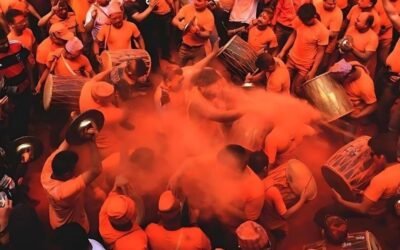
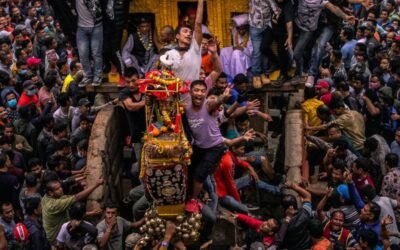
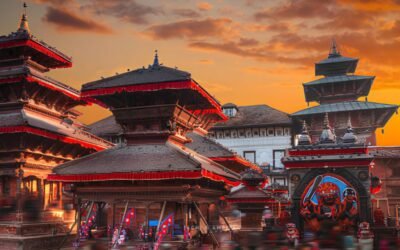
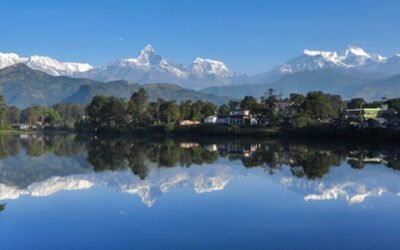
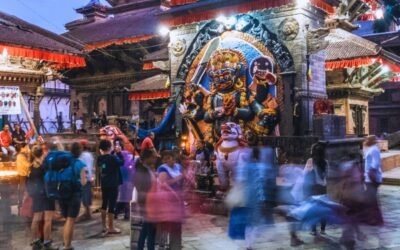
Bhaktapur sounds like a great place to visit. I am going to save this place for my future trip to Nepal that I am planning for later this year. Thank you for sharing this!
How amazing to be able to join in and see an authentic festival like the Nepali New Year! I love how you discovered that there is so much more to Kathmandu than Bhaktapur Durbar Square. That’s my favorite part of really diving deeply into a single place and exploring all corners.
I am a lover of architecture and I’m fascinated with art so visiting this place is something just right for me. I love all these details and sculptures. An amazing destination!
Thank you for reminding me how wonderful Nepal is and how much heritage I saw there. It’s been a long while since I visited. I loved the tiny figures of Gods everwhere and the animals of the Gods which seem to have bigger importance than in Indian Hinduism. I love your photos on Bhaktabur, Dubar Square is just marvelous piece of histoory and I could recommend anyone to see it at least once in a lifetime.
I can’t begin to imagine what a sepcial experience it must’ve been visiting Bhaktapur! The art and architecture are seriously so beautiful it’s no wonder they call it a living museum. I’d definitely love to do a cooking or pottery making class myself and great tip about wearing comfy shoes!
I have severe wanderlust to go to Nepal! I’m hoping to go in the next two years. I’ve never heard about Bhaktapur Durbar Square. The architecture and carvings are beautiful. Can you imagine the amount of time it took to painstakingly carve the design?! Simply stunning. I would love to experience the festivities of the Bisket Jatra New Year celebration with the singing and dancing. Thanks for sharing this detailed post!
Aren’t spontaneous trip plans just the best? I feel like they end up topping the original plans just from the excitement! That’s great that they were able to recover enough from the earthquake to still maintain an amazing place to visit. I love all of the ornate architecture in the burnt red!
Truly Shabe, the spontaneous are the best and this has been proved time and again for us.
It is wonderful to know that this tradition has been well-kept for this generation or future generation to experience. It gives us insight as to what others have done in the past and tells so much about their society. I also find it interesting that serpents were considered deities. I would be so scared if I take a bath and see a serpent! The baths also show similarities of societies in different parts of the world as it reminded me of the Roman Baths.
Thank you Justine!
Wow, it certainly looks like you picked the right time to travel here! You definitely got to experience the true culture of Nepal and this town in particular. It looks like it was a fantastic celebration!
It was really a great celebration and we saw the culture of the place so close. Thank you Sara, for the comment.
I loved Bhaktapur too when I visited Nepal a few years back. You were lucky to witness the Bisket Jatra and Sindur Jatra there, I wish to go back there and looking at your pictures I should plan around Bisket Jatra and Sindur Jatra too.
Thanks Suman. Yes, it was quite lucky that we visited during the time of Bisket Jatra!
This looks pretty interesting. Especially for a European eye, like mine. Architecture is unusual and there are some interesting happenings.
Thanks Aleksandr! Bhaktapur is quite interesting. I am sure you will have a good time here especially with your photography skills.
I have actually never heard of Bhaktapur in Nepal and its interesting to read about how historically and culturally rich a city it is. I wouldn’t have thought about including it in my itinerary because it has never come up in my research but a city that is considered “A Living Museum” of Newari art and architecture sounds like one that deserves to be explored. Love the architecture of their temples.
Thank you Medha. I would say Bhaktapur is a hidden delight of Nepal with stunning architecture. Keep it in your Nepal itinerary.